When I was a little kid, I remember I used to draw Darth Vader, Boba Fett and the Imperial Tie-Fighters compulsively.
Whenever I had a spare bit of paper or whenever my mind wandered, I would end up doodling variations of those images. I also drew (and coloured in) a few fanboy, speculative comic-book covers; one with Fett crawling out of the Sarlaac pit and another of the Ewok Wicket.
I was a poorish kid from a poorish family (queue ‘Bohemian Rhapsody’), so at that stage I wasn’t buying any Star Wars comics; and was instead making up my own entertainment and letting my imagination run wild.
I have had a scattered, remote relationship with Star Wars comics in the past, as with the whole Expanded Universe in general. I’ve read bits and pieces over the years, particularly Dark Empire and some of the earliest Dark Horse stuff, and the quality level has always been changeful and unpredictable, despite a lot of excellent work.
But one of those things that had been bound to happen when the Disney Corporation acquired Lucasfilm was that Disney’s other massive acquisition, Marvel Comics, would be free to start putting out Star Wars comics again, particularly in the approach to the Episode VII movie later this year.
The question then was what kind of comics would this entail and in what time-frame of the fictional universe? After all, there were several possible time-frames just around the existing films that could’ve been chosen, and a post-Return of the Jedi time-frame would’ve been quite logical perhaps to bridge the gap between ROTJ and the upcoming Star Wars: Episode VII.
Instead Marvel has chosen to focus in on the period immediately following the events of a A New Hope. It’s as good a choice as any and it allows for some exploration of a key period in the saga’s chronology.
So Marvel initially launched their Star Wars line with three main titles, Star Wars, Darth Vader and Princess Leia. Other spin-off Star Wars titles will follow no doubt, as there are just so many possibilities; and for one thing, we know there’s a Lando Calrissian series started now, along with Kanan: The Last Padawan, which I am storing up to enjoy later in the year.
But sticking for now with what we’re receiving so far, the decision to focus in on the era immediately after A New Hope means we’re exploring the earliest possible time-frame within the saga, and possibly suggests that down the line we might get into later eras in the existing film-saga chronology.
But with the new film trilogy beginning later this year, we’ll almost certainly getting tie-in comics relating to that era too, so we’re probably not likely to see any comics set in the ESB, ROTJ or the Prequel era for a while.
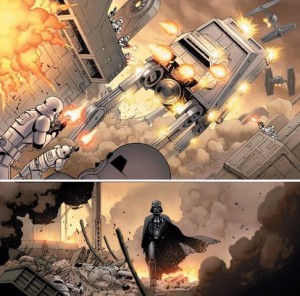
Set immediately after the climatic events of A New Hope, Star Wars #1 follows Luke, Leia and Han (and Chewie) carrying out continued rebel operations against the empire. Setting these stories in this time-frame allows us to fill in the gaps in that hazy period between A New Hope and The Empire Strikes Back. Even as someone very clued-in to the Star Wars mythology (though admittedly only partly clued-in to the mythology of the Expanded Universe), this period of time between ANH and ESB is something I don’t think I’ve personally seen explored before (other than in the old Splinter of the Mind’s Eye novel, which I’m not sure is even counted anymore).
The old Shadows of the Empire novel famously covered the gap between ESB and Return of the Jedi, but this here in Star Wars #1 was new ground for me.
I was uncertain as to whether I’d be able to embrace whatever it was I was about to read; but literally soon as you see Tie-Fighters and Star Destroyers, you feel like you’ve come home (or Artoo or Chewbacca, for that matter).
The most impressive thing about this series’ first few issues is that it really does *feel* like the A New Hope era, right down to the last detail; that whole vibe is captured (or recaptured) immaculately, to the extent that you feel like you’re reading something put out in 1977.
While nothing spectacular happens, Star Wars #1 gives us a simple re-entry point, reintroducing us to the ANH-era Luke, Leia and Han we’re so familiar with. The familiar trio sneaking around passed Stormtroopers and trying to blow up an Imperial base feels like a natural add-on to A New Hope; even the interior looks like the ANH-era Death Star, and this comic knowingly and naturally plays to all the nostalgia.
All the old elements are there and you can tick them off on your check-list as you go along. Han’s disrespectful treatment of Threepio? Check. Artoo’s key usefulness in a mission? Check. The Falcon camouflaging itself amid a garbage dump? Check. Chewie wearing safety goggles while he frantically tries make repairs to the Falcon? Check. Vader looking up wistfully as the Falcon flies away (an image right out of Hoth and ESB)? Check. Incompetent Stormtroopers with zero targeting skills? Check. Vader sensing Luke’s presence through The Force? And so on.
Vader’s arrival obviously picks up the interest level further; and without doubt, everyone reading a comic or book where Darth Vader shows up automatically runs the Imperial March music in their heads, right? It’s just pure reflex.
Let’s be honest, these Star Wars comics are essentially a nostalgia exercise, particularly as they’re not intended to play into the imminent new film series as far as I’m aware. There’s nothing wrong with that, of course. It does mean we’re not likely to get any particularly deep, probing material out of it or anything of lasting impact or consequence. But it doesn’t mean we can’t have fun with it, particularly when the writers are handling the mythology with due reverence and are seemingly well versed in that mythology (although who isn’t?).
And even within that primarily nostalgia based framework, these comics can throw up some interesting plot details and newish ideas. Chewbacca trying to assassinate Vader, for example, is a great little moment and one of those things you don’t really imagine happening.
The assembly line, with droids manufacturing the Tie-Fighters, makes for a cool, novel idea, and it draws you in both conceptually and visually, while Luke and Leia arriving in the familiar Jabba’s Palace disguises from Return of the Jedi again gives us that sense of connection and familiarity. How else could Star Wars #1 end but with Vader and Luke drawing lightsabers and sizing each other up, you might ask?
However, on second thought I’m not sure it works so well to suggest the the confrontation in ESB wasn’t the first father/son lightsaber encounter.
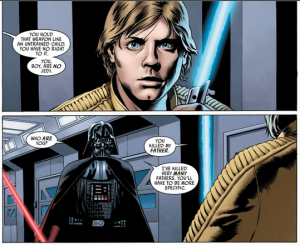
This is always a danger when toying with an established fictional history/canon. Something is taken away from that iconic Luke/Vader duel in The Empire Strikes Back if we now say that it wasn’t the first time they’d sized each other up. Part of the power of that famous confrontation is that it’s the first time they square up to each other.
So, while I can understand the temptation the writers had here to show Luke and Vader drawing sabers, it’s a temptation I think they might’ve resisted. It’s also just too obvious a thing to have happen, especially so early in the narrative.
I’m sure a lot of other fans loved it though, so I admit I may be in the minority in thinking this.
There actually isn’t a great deal to say about Star Wars #2 and #3 that isn’t expressed about #1. It’s basically more of the same.
By #3 we’ve got the familiar Scout-Walkers, AT-ATs, Phantom Menace-era Assault Tanks, Luke fleeing Stormtroopers on a speeder-bike… all the stuff we love. Most of what we’re responding to is, in essence, visual aesthetics and little fan-boy sweeteners. Again, it’s mostly playing to nostalgia, but in about as good a way as could be done. While it does expand on the existing mythology somewhat, it doesn’t add anything particularly revelatory or groundbreaking. And it probably isn’t intended to.
But if you enter into this series with that understanding, you’ll find it perfectly enjoyable; particularly if, like me, you’re a total Star Wars die-hard and you spent half your childhood wearing out your Original Trilogy VHS tapes. In that context, you’ll find various little moments to get a rise out of. Vader cutting down a giant AT-AT with his lightsaber may somehow feel somehow a touch unrealistic, but it’s undeniably cool to watch him doing it; and is actually the kind of thing that gets you thinking ‘I wish they’d had that in one of the movies’.
The main cover to Star Wars #4 is conceptually superb, though it suffers somewhat from the imperfect rendering of Vader’s ‘face’ (or mask), which blunts the desired effect a little. But having that image of Vader superimposed over that famous Tatooine twin sunset and with the Lars homestead visible is a visual primed to capture the imaginations of most Star Wars fans; tonally, it’s perfect. This effect somewhat continues on the first page, with the familiar sight of Jabba’s Palace bathed in Tatooine desert sunlight and surrounded by Stormtroopers on Banthas, with Tie-Fighters flying overhead.
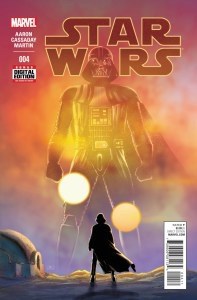
#4 is probably the best of the first four issues of the Star Wars title.
It gives us some beautiful, emotive (for Star Wars fans anyway) Tatooine twin-sunset effect; there’s a page where we see the twin suns coloring the atmosphere around Mos Eisley and it encapsulates all the aesthetic, tonal resonance of the films and the lingering place those kinds of familiar aesthetic have on our sense-memories.
But again, I’m highlighting nostalgia elements here, which is what these comics continue to play on as its primary strength. The confrontation between the Rodian gang and the as-yet-unidentified Bounty Hunter type figure is classically like something right out of the early Expanded Universe, getting into the gritty underbelly of the Original Trilogy universe.
The return of Vader to Jabba’s Palace is a lot less interesting here than in Darth Vader #1 (reviewed here) but generally it’s difficult to go wrong with those dynamics. Vader being intolerant of Salacious Crumb’s ear-piercing cackle is funny (“If you value that creature’s life, tell it to never again do that in my presence”, he tells Jabba); one imagines Vader has to fight the urge to Force-choke the annoying little creature. Seeing Jabba’s sail barge soaring through a desert sandstorm and his henchmen mercilessly hunting Banthas for sport is one of those cool little details that draws from existing source-material and adds something new to it.
We also get some more engaging colouring of Vader’s mind; for example there’s a beautiful moment where Jabba, discussing Luke, says casually to Vader “Who knew anyone of note was ever born on Tatooine…?” In response to which we see a stark, moody shot of Vader’s face, the twin suns of Tatooine reflected in his eye-pieces.
It’s a terrific, evocative little moment that reaches right into the solar-plexus of the Star Wars mythology and the Skywalker myth in particular; and it’s little resonating moments like these are the main pay-off in reading any of these Star Wars comics.
Darth Vader, for that matter, is probably the best and most interestingly explored character in all of these comics so far, both in this Star Wars main title and in the Darth Vader solo series; that’s not really surprising, as Vader was always going to be the most psychologically engaging to study. Boba Fett’s appearance at the end, catching up with the same Rodian thugs as the previous mystery figure in Mos Eisley, is suitably enticing, ensuring that we read on. Incidentally, this issue also reintroduces us to the likes of Mon Mothma and Admiral Ackbar.
Star Wars #5 splits the narrative primarily between Luke returning to Tatooine to search for Obi-Wan’s desert home and Boba Fett knocking heads and carrying out his mission for Vader to capture Luke. There’s a terrific image on page 6 of Fett and one of his victims silhouetted against the twin-sun Tatooine backdrop that plays aesthetically like something out of the prequels. Fett taking his mission into the Mos Eisley Cantina gives us a few familiar faces from the iconic ANH scene (don’t pretend you’re not getting the cantina band music in your head as you read this scene). It also shows us how absolutely ruthless Boba Fett is, as he shows no mercy in his rush to fulfil his assignment and earn his pay.
Luke being ambushed by Tusken Raiders outside Kenobi’s old home is pretty much a given; but hey, if I was writing this I wouldn’t be able to resist that either. Finally, upon returning to Obi-Wan’s abandoned home, Boba Fett catches up with the young Jedi and the issue of course ends right there, letting us know we’ve got a Fett/Skywalker clash ahead.
That actually works pretty good for me; watching the Return of the Jedi fight sequence on Jabba’s skiff, I always felt like Fett and Luke had fought each other some time before and that they were two familiar foes with a history (beyond just the brief skirmish on Bespin in ESB, I mean).
So this would fit that nicely. It was pretty obvious that Luke wouldn’t be successfully taken to Vader; and this is confirmed in Star Wars #6 where Boba Fett fails to capture his slippery Jedi target.
The Fett/Skywalker clash in Obi-Wan’s old house doesn’t give us much other than the novelty value; except, as mentioned, it provides a nice new undercurrent to the famous ROTJ clash. Luke discovering Obi-Wan’s old journal is fascinating though and could potentially give us something new and interesting in future issues. I’m going to guess it may relate to how Luke makes the transition to eventually learning to interact with Kenobi’s blue ghost.
This may relate to the “new training” Yoda promised Obi-Wan at the end of Revenge of the Sith and the reference to Qui-Gon Jinn having cheated death. If so, this would be a really fascinating area to explore, particularly in bridging the gap between ROTS and the Original Trilogy – which is precisely what I would want comics like this to be doing. #6 also has Vader discover for the first time that the new Jedi who blew up the Death Star is in fact his long-lost son, which again is one of those previously unseen moments in the film-side of the Star Wars mythology and a series like this is perfectly placed to give us those moments.
The revelation/arrival of Han Solo’s ‘wife’ (Sana Solo) gives us a bit of a soap-opera cliffhanger too!
All in all, these opening six issues of this Star Wars series maintain roughly the same quality level, and are a steady, enjoyable read, even if they’re nothing particularly revelatory.
The characters and this classic, timeless part of the Star Wars universe itself are in the good, steady hands of writers and producers who know, love and understand the mythology as much as we do. Jason Aaron’s handling of the characters and stories in this central title is solid, while artist John Cassaday and colorist Laura Martin create an effective nostalgia vibe, somehow managing to perfectly capture that A New Hope aesthetic in a way that’s almost as if the storyboard artists from 1977 are producing these comics.
None of it is very grown-up at this point and it does feel like something pitched at a younger readership at times, but this doesn’t overly detract from the enjoyment.
By the way, whoever came up with the idea of those retro action-figure variant covers is a genius.

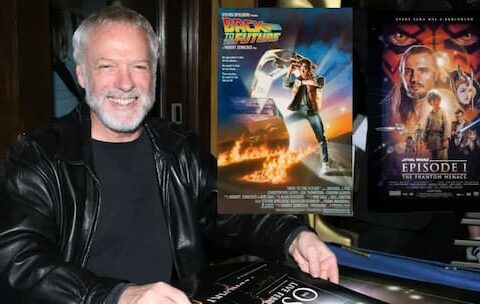
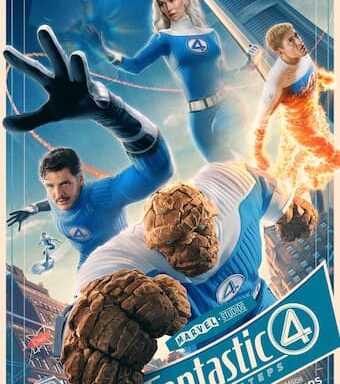
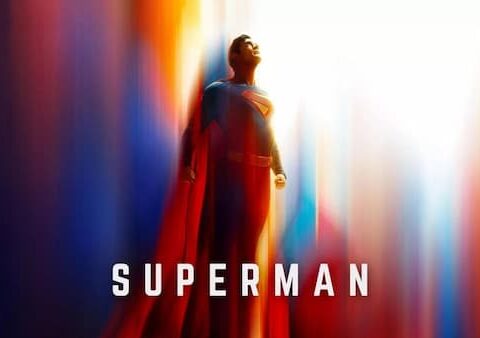

My job as a father is complete…..My 11 year old son loves Star Wars and Indiana Jones. We occasually visit a nearby comic store too, where his eyes pop out of his sockets, in awe of all the amazing back issues.
That’s great. It’s great that he loves the classics/old stuff and not just contemporary things.